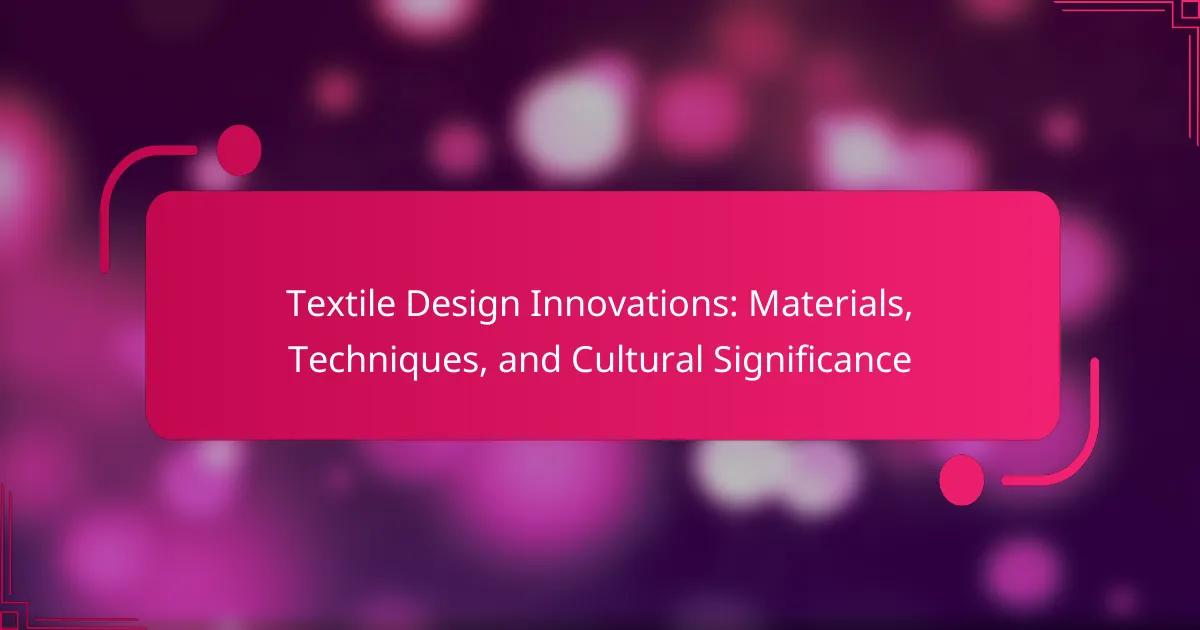Textile design innovations are reshaping the industry by focusing on sustainable materials, advanced techniques, and cultural significance. Recent advancements include eco-friendly fabrics, smart textiles, and bioengineered fibres that enhance functionality. Innovative techniques improve durability and comfort while preserving traditional craftsmanship. Leading brands like Nike and Stella McCartney are driving these changes, reflecting a growing consumer demand for responsible and meaningful fashion.
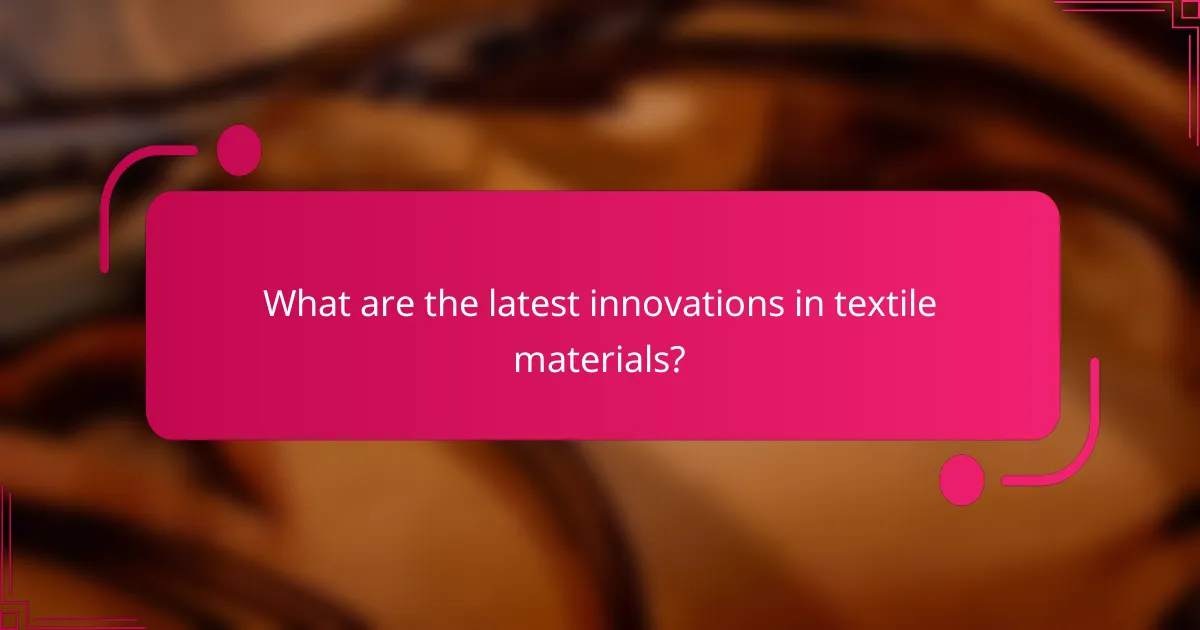
What are the latest innovations in textile materials?
Recent innovations in textile materials include sustainable fabrics, smart textiles, and bioengineered fibres. These advancements enhance functionality, reduce environmental impact, and improve user experience. For example, fabrics made from recycled plastics offer durability while minimising waste. Smart textiles integrate technology, enabling features like moisture management and temperature regulation. Bioengineered fibres, such as those derived from algae or fungi, present unique properties and sustainability benefits. These innovations reflect a growing trend towards eco-friendly and multifunctional textile solutions.
How are sustainable materials reshaping the textile industry?
Sustainable materials are significantly reshaping the textile industry by promoting eco-friendly practices and reducing waste. Innovations such as organic cotton, recycled polyester, and biodegradable fabrics are gaining traction. These materials not only lower the environmental impact but also enhance brand reputation and consumer loyalty. As a result, companies adopting sustainable materials are often viewed as leaders in ethical fashion. The shift towards sustainability is not just a trend; it reflects a deeper cultural significance as consumers increasingly prioritise environmental responsibility in their purchasing decisions.
Which high-tech fabrics are gaining popularity in fashion?
High-tech fabrics gaining popularity in fashion include smart textiles, moisture-wicking materials, and sustainable fabrics. Smart textiles integrate technology for enhanced functionality, while moisture-wicking materials improve comfort during physical activity. Sustainable fabrics, made from recycled or organic materials, appeal to eco-conscious consumers. These innovations reflect a shift toward performance and sustainability in textile design.
What role do natural dyes play in modern textile design?
Natural dyes are increasingly significant in modern textile design, emphasising sustainability and cultural heritage. They offer eco-friendly alternatives to synthetic dyes, reducing environmental impact. Natural dyes, derived from plants, insects, and minerals, provide unique colour palettes that enhance artistic expression. Their use fosters a connection to traditional practices, promoting awareness of cultural significance in textile arts. As a result, designers are innovating techniques to incorporate these dyes, blending modern aesthetics with historical craftsmanship.
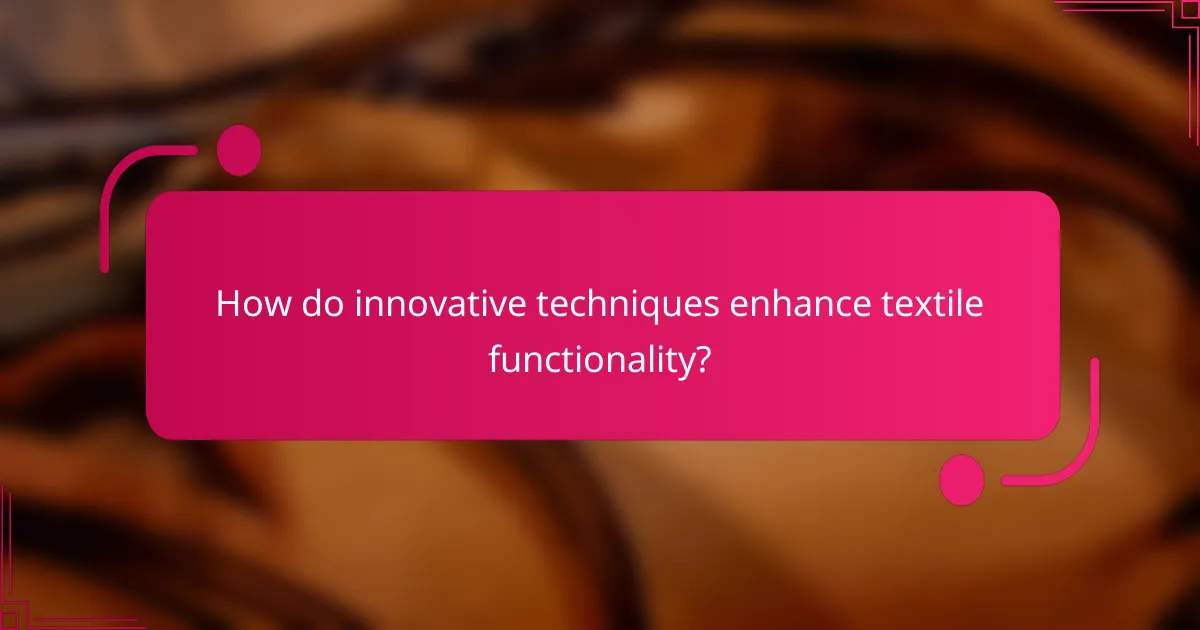
How do innovative techniques enhance textile functionality?
Innovative techniques significantly enhance textile functionality by introducing advanced materials and processes. These innovations improve durability, moisture management, and comfort. For example, smart textiles incorporate sensors that monitor body temperature and adjust accordingly. Additionally, sustainable practices in textile design reduce environmental impact while maintaining high performance. Such advancements reflect a growing cultural significance in fashion and functionality, merging aesthetic appeal with practical benefits.
What are the benefits of digital printing in textile design?
Digital printing in textile design offers significant benefits, including enhanced creativity, faster production times, and reduced waste. This technique allows for intricate designs and customisation without the constraints of traditional methods. It enables designers to experiment with colours and patterns, leading to innovative textile creations. Additionally, digital printing minimises the environmental impact by using less water and energy compared to conventional printing processes.
How does 3D weaving transform traditional textile methods?
3D weaving transforms traditional textile methods by integrating complex geometries and structures, enhancing design possibilities. This innovative technique allows for the creation of multi-dimensional fabrics that are stronger and lighter than conventional textiles. Additionally, 3D weaving reduces material waste, promoting sustainability in textile production. It fosters new applications in fashion, automotive, and aerospace industries, showcasing the cultural significance of modern textile innovations.
Which techniques are used for smart textiles integration?
Smart textiles integration employs techniques like weaving, knitting, and printing. These methods incorporate electronic components into fabrics, enabling functionalities such as sensing, heating, and communication. Weaving integrates conductive fibres into traditional textile processes, while knitting allows for flexible designs. Printing techniques apply electronic inks to create patterns that enhance fabric capabilities. Each method contributes uniquely to the development of innovative smart textiles, enhancing their applications in various sectors.
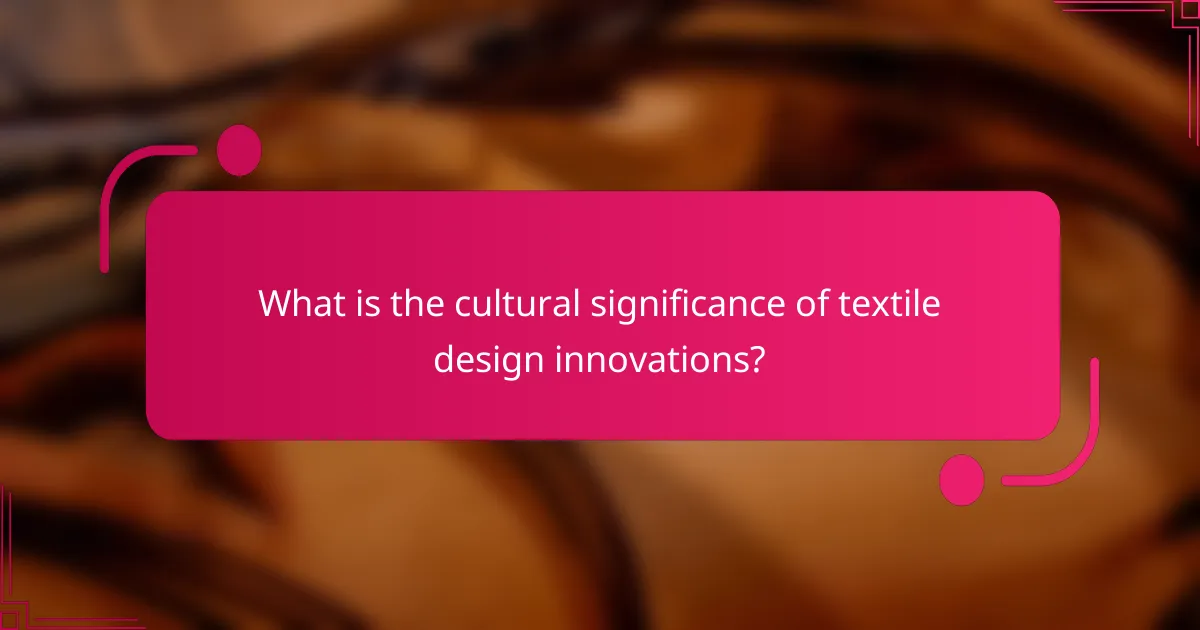
What is the cultural significance of textile design innovations?
Textile design innovations hold significant cultural value as they reflect societal changes, heritage, and identity. These innovations often incorporate traditional techniques while embracing modern materials, enhancing both functionality and aesthetic appeal. For example, the use of sustainable fibres symbolises a growing environmental consciousness. Additionally, innovations can preserve cultural narratives through patterns and motifs, serving as a bridge between generations. As a result, textile design fosters community connections and promotes cultural exchange on a global scale.
How do textiles reflect cultural heritage in contemporary designs?
Textiles reflect cultural heritage in contemporary designs through innovative materials and techniques that celebrate traditional craftsmanship. Designers incorporate historical patterns, colours, and motifs, creating a dialogue between past and present. This fusion enhances the cultural significance of textiles, making them not only functional but also expressive art forms. For example, the use of natural dyes and hand-weaving techniques preserves ancestral knowledge while appealing to modern aesthetics. Such practices contribute to sustainable design, connecting consumers with the cultural narratives behind each piece.
Which global events influence textile trends and innovations?
Global events such as economic shifts, technological advancements, and cultural movements significantly influence textile trends and innovations. Economic fluctuations can drive demand for sustainable materials, while advancements in technology lead to new manufacturing techniques. Cultural movements often inspire design aesthetics and material choices. For instance, the rise of eco-consciousness has popularised organic textiles. Additionally, global events like fashion weeks showcase innovations and set trends that ripple through the industry.
What is the impact of local craftsmanship on modern textile design?
Local craftsmanship significantly influences modern textile design by integrating traditional techniques and cultural narratives. This synergy enhances the aesthetic appeal and authenticity of contemporary textiles. For instance, artisans often employ age-old methods, such as hand-weaving or dyeing, which infuse designs with unique textures and colours. Additionally, local materials sourced from specific regions contribute to the sustainability and environmental consciousness of modern textile practices. This connection to heritage not only preserves cultural identities but also fosters innovation in design, making textiles more meaningful and impactful in today’s market.
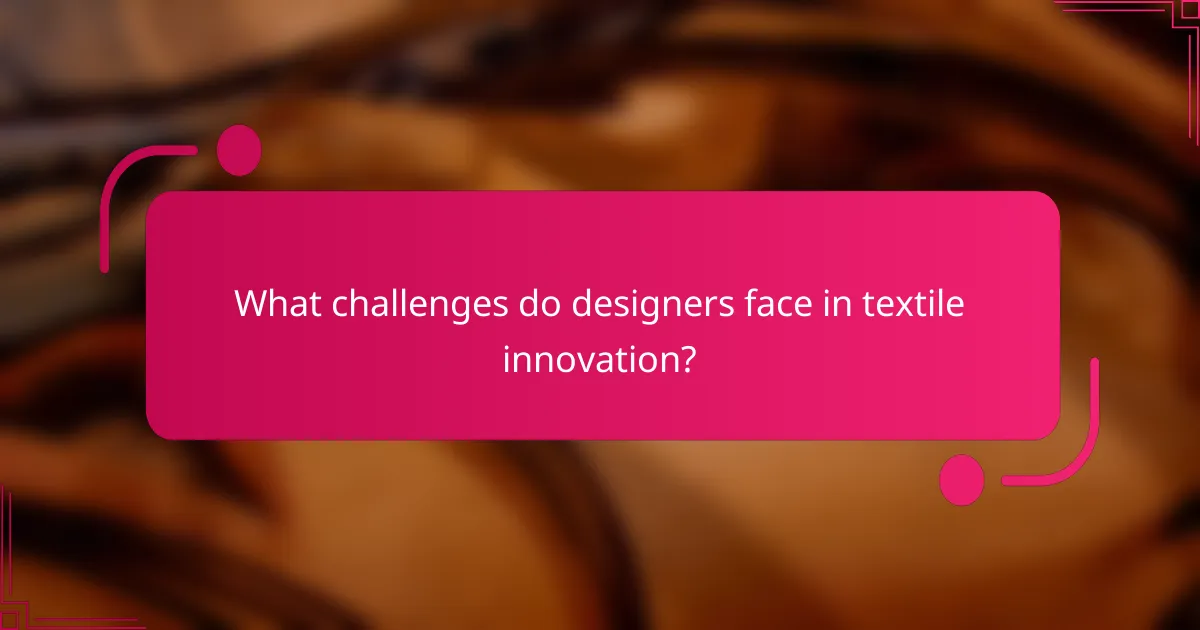
What challenges do designers face in textile innovation?
Designers face challenges in textile innovation due to material limitations, sustainability concerns, and cultural relevance. The quest for eco-friendly materials often conflicts with performance requirements. Additionally, integrating traditional techniques with modern technology presents design complexities. Balancing innovation with cultural significance is essential yet difficult, as it requires sensitivity to heritage while pushing creative boundaries.
How do cost and accessibility affect the adoption of new materials?
Cost and accessibility significantly influence the adoption of new materials in textile design. High costs can limit experimentation and innovation, while accessible materials encourage broader use and integration. For instance, sustainable textiles often face higher production costs, impacting their market reach. Conversely, affordable alternatives can promote widespread adoption, fostering creativity and cultural significance in design. The balance between cost and accessibility determines how quickly new materials become mainstream in the industry.
What environmental concerns are associated with textile production?
Textile production raises significant environmental concerns, including water pollution, waste generation, and resource depletion. The dyeing process often contaminates water bodies with harmful chemicals. Additionally, the industry contributes to high levels of textile waste, with millions of tons discarded annually. The cultivation of raw materials, such as cotton, can lead to soil degradation and excessive water use. Sustainable innovations in textile design aim to mitigate these issues by promoting eco-friendly materials and production techniques.
How do consumer preferences shape textile innovation trends?
Consumer preferences significantly influence textile innovation trends by driving demand for sustainable, functional, and culturally relevant materials. As consumers become more environmentally conscious, brands are increasingly adopting eco-friendly materials like organic cotton and recycled fibres. Additionally, the rise of smart textiles, which integrate technology for enhanced functionality, reflects consumer interest in performance and convenience. Cultural significance also shapes design choices, as brands seek to resonate with diverse consumer backgrounds and values. This interplay encourages continuous evolution in textile techniques and applications to meet changing preferences.
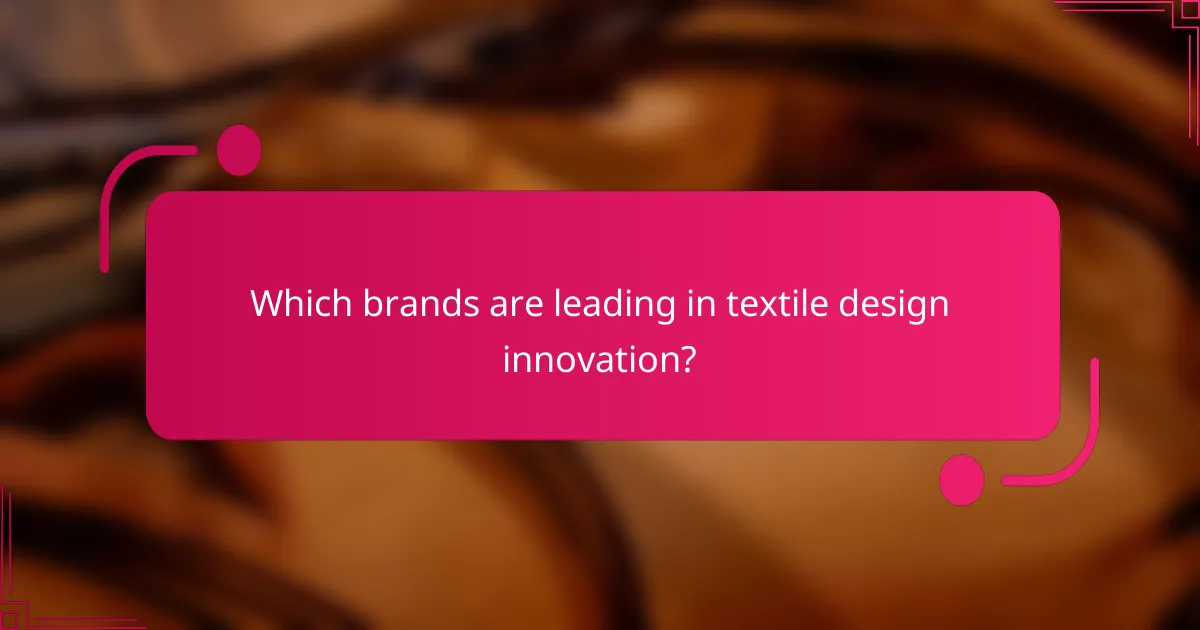
Which brands are leading in textile design innovation?
Leading brands in textile design innovation include Nike, Adidas, and Stella McCartney. These brands focus on sustainable materials, advanced manufacturing techniques, and cultural relevance. Nike integrates recycled materials, while Adidas emphasises biodegradable textiles. Stella McCartney champions ethical practices, demonstrating a commitment to environmental impact. Each brand shapes the future of textiles through unique approaches and collaborations.
What makes certain brands stand out in sustainable textile practices?
Certain brands stand out in sustainable textile practices by prioritising innovative materials, ethical production techniques, and cultural significance. These brands often utilise organic fibres and recycled materials, reducing environmental impact. They adopt transparent supply chains, ensuring fair labour practices. Unique attributes, such as local craftsmanship and community engagement, enhance their appeal. As a result, these brands resonate with consumers seeking authenticity and sustainability in their fashion choices.
How are luxury brands incorporating innovative textiles into their collections?
Luxury brands are increasingly integrating innovative textiles into their collections to enhance sustainability and aesthetics. These brands utilise advanced materials like bio-fabricated textiles and recycled fibres, which reduce environmental impact. Techniques such as 3D knitting and digital printing allow for intricate designs and personalised fits. Cultural significance is emphasised through collaborations with artisans, showcasing traditional craftsmanship alongside modern technology. This fusion creates unique, limited-edition pieces that resonate with consumers seeking both luxury and responsibility.

What future trends can we expect in textile design?
Textile design is shifting towards sustainability, technology integration, and cultural storytelling. Innovations include biodegradable materials, smart textiles, and techniques that honour traditional craftsmanship. The emphasis on eco-friendly practices reflects growing consumer awareness and demand for responsible fashion. As a result, designers are increasingly blending modern technology with cultural significance, creating textiles that are not only functional but also meaningful.
How will technology continue to influence textile design innovations?
Technology will significantly enhance textile design innovations through advanced materials, automation, and sustainable practices. Innovations like 3D printing enable intricate designs that were previously impossible. Smart textiles integrate electronics, offering functionality beyond aesthetics. Sustainable technologies promote eco-friendly materials, reducing environmental impact. Digital design tools streamline the creative process, allowing designers to experiment rapidly. As a result, technology shapes not only the aesthetics but also the functionality and sustainability of textiles, reflecting cultural values and advancing the industry.
Which emerging markets are driving changes in textile design?
Emerging markets like India, Bangladesh, and Vietnam are significantly influencing textile design innovations. These regions are integrating sustainable materials and traditional techniques into modern designs.
India’s textile industry is embracing organic cotton and natural dyes, enhancing both environmental sustainability and cultural heritage. Bangladesh focuses on innovative weaving techniques, boosting efficiency and creativity. Vietnam is leveraging technology, such as digital printing, to blend traditional patterns with contemporary aesthetics.
These markets are not only enhancing design but also driving global trends towards sustainability and cultural significance in textiles.
What are the best practices for integrating innovation in textile design?
To effectively integrate innovation in textile design, focus on sustainable materials, advanced techniques, and cultural relevance. Embrace eco-friendly fabrics that reduce environmental impact while enhancing durability. Incorporate cutting-edge technologies such as 3D knitting and digital printing, which allow for intricate designs and customisation. Collaborate with diverse cultures to inspire unique patterns and narratives, enriching the textile’s story and appeal. Regularly engage with industry trends and consumer feedback to adapt and innovate continuously.
